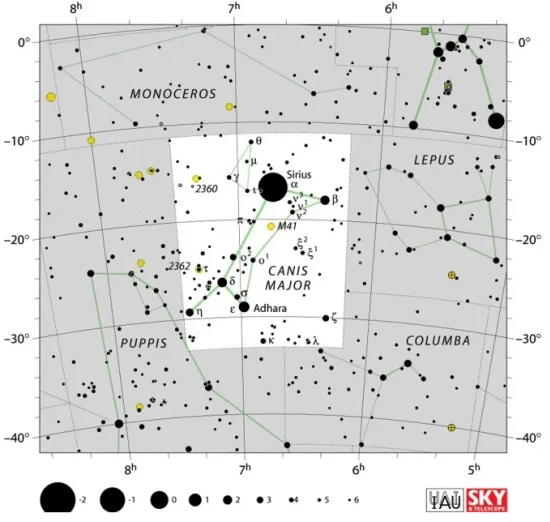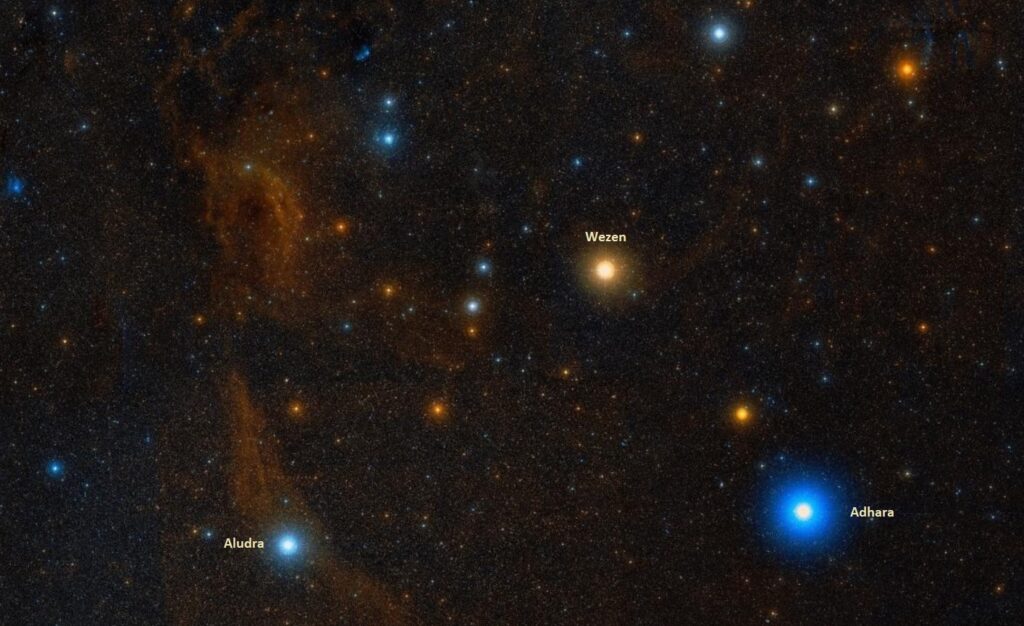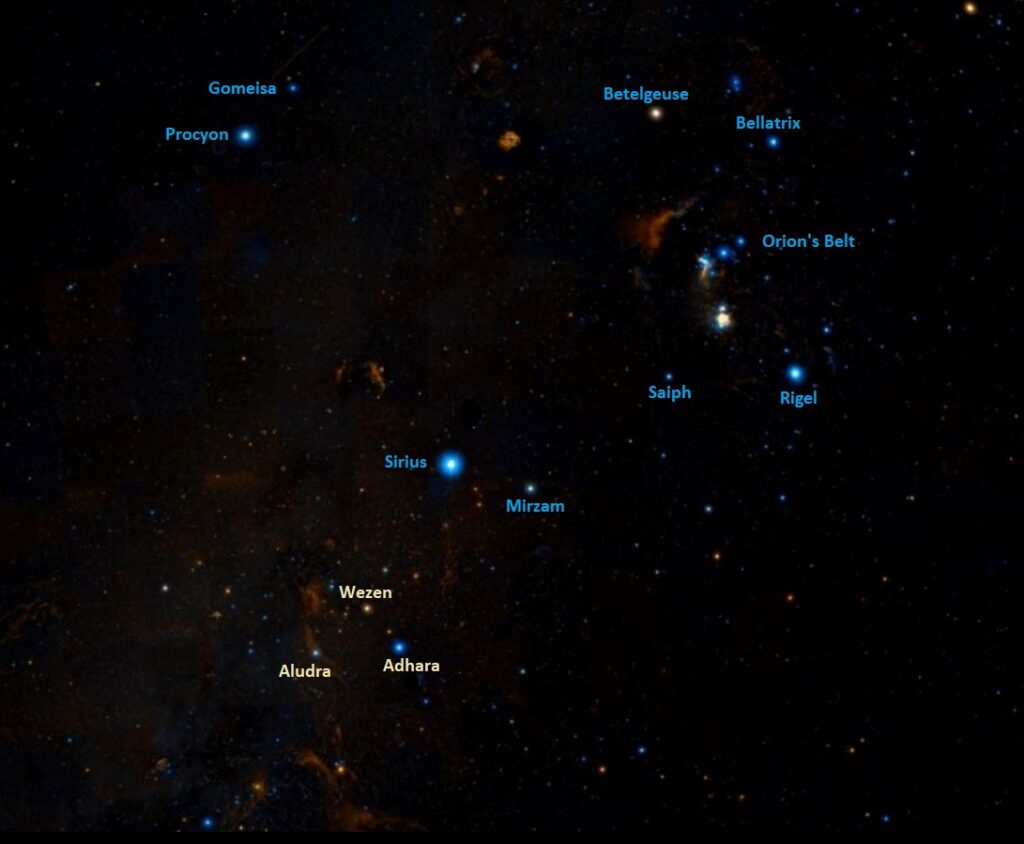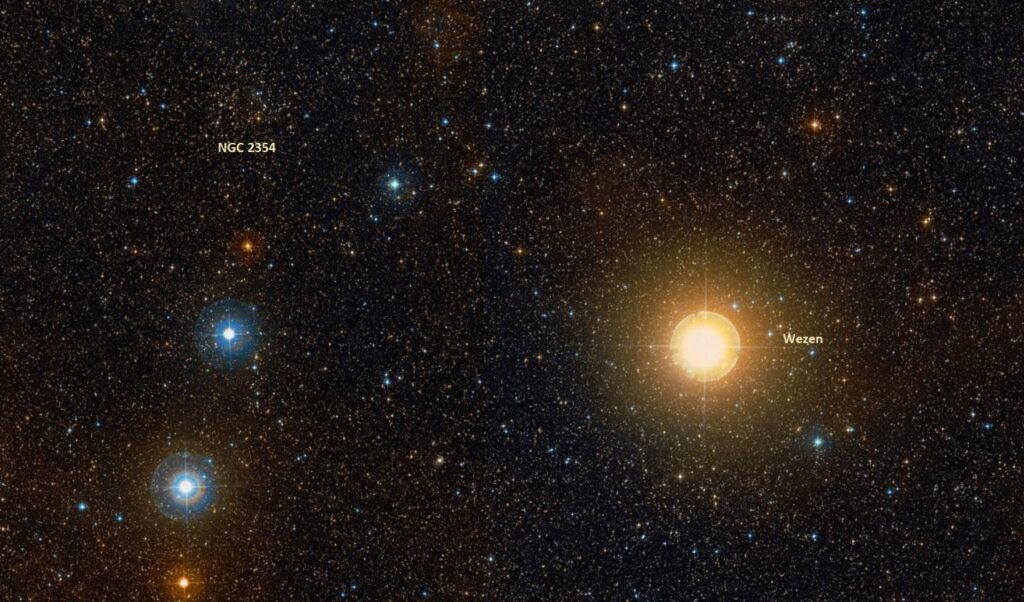Wezen, Delta Canis Majoris (δ CMa), is a yellow-white supergiant star located in the constellation Canis Major. It marks the Great Dog’s hind quarters. With an apparent magnitude of 1.824, it is the third brightest star in Canis Major, after Sirius and Adhara. It lies at an approximate distance of 1,600 light years from Earth.
Star type
Wezen has the stellar classification F8 Ia, indicating a supergiant star appearing white or yellow-white in colour. It is the primary component of a multiple star system. The star has a mass about 16.9 times that of the Sun and has expanded to a size of 215 solar radii. Its projected rotational velocity is about 28 km/s. This means that, taking into account its size, it may take a year to complete a rotation. With an effective temperature of 6,390 K, it shines with 82,000 solar luminosities. The star’s estimated age is 12 million years.
Even though it is a young star, like other massive stars, Wezen has evolved quickly and will not have a very long life. It has already stopped fusing hydrogen in its core and, within the next 100,000 years, it will evolve into a red supergiant. With a mass of almost 17 solar masses, it will most certainly end its life as a brilliant supernova.

Wezen (Delta Canis Majoris), image: Wikisky
Facts
Wezen has been used as a spectral standard for its class since 1943. The star’s spectrum is one of the stable anchor points for the Morgan-Keenan system of spectral classification, used to classify other stars.
On average, Wezen is the 36th brightest star in the sky. It is only slightly fainter than Alioth and Dubhe in Ursa Major and Mirfak in Perseus, about as bright as Regor in Vela, and just outshines Kaus Australis in Sagittarius, Alkaid in Ursa Major, Sargas in Scorpius, and Avior in Carina.
Wezen is one of the 27 stars featured on the flag of Brazil. Each of the stars symbolizes a Brazilian federative unit and Wezen represents the state of Roraima. Other Canis Major stars represented on the flag are Sirius (Alpha Canis Majoris), Adhara (Epsilon Canis Majoris), Mirzam (Beta Canis Majoris), and Muliphein (Gamma Canis Majoris).
Name
The name Wezen (pronunciation: /ˈwiːzən/) comes from the Arabic al-wazn, meaning “weight.” It is the star’s traditional name. It has also been spelled Wesen, Wezea, and Alwazn. Traditionally, the name was also used for Beta Columbae, now formally known as Wazn.
The name Wezen was approved by the International Astronomical Union’s (IAU) Working Group on Star Names (WGSN) on July 20, 2016. It formally applies only to the component Delta Canis Majoris Aa.
The Chinese know Delta Canis Majoris as 弧矢一 (Hú Shǐ yī), the First Star of Bow and Arrow. The Chinese Bow and Arrow asterism is part of the Well mansion, one of the southern mansions of the Vermilion Bird. The asterism is formed by Wezen with Aludra (Eta Canis Majoris), c Puppis (HD 63032), Chi Puppis, Omicron Puppis, k Puppis (HD 61555 and HD 61556), Adhara (Epsilon Canis Majoris), Kappa Canis Majoris, and Pi Puppis.
The 17th century Egyptian astronomer Al Achsasi Al Mouakket listed Delta Canis Majoris as Thalath al Adzari, meaning “the third virgin.” The name was later translated into Latin as Tertia Virginum. Wezen and its neighbours Adhara, Aludra and Omicron2 Canis Majoris were collectively known as Al ʽAdhārā, meaning “the virgins.” Epsilon Canis Majoris, the star known as Prima Virginum (“the first virgin”), kept the name Adhara.
Location
Wezen is very easy to find because of its proximity to Sirius, the brightest star in the sky. Wezen lies at the top of a triangle of stars just under Sirius and can be seen about 10 degrees south-southeast of the star. The triangle is formed by Wezen with Adhara and Aludra. Sirius is easy to identify because of its brightness, but the stars of Orion’s Belt – Alnitak, Alnilam and Mintaka – can also be used for orientation. A line extended from the Belt stars to the southeast leads directly to Sirius.
Wezen can also be found by extending a line from Betelgeuse, the right shoulder of Orion (left from our perspective) through Sirius. It is the first bright star on this imaginary line.
Wezen can be used to find the bright, large open cluster NGC 2354, which lies about 1.3 degrees east-northeast of the star. The cluster has an apparent magnitude of 6.5. About 15 of its stars can be resolved in binoculars.
Constellation
Wezen is located in the constellation Canis Major. Best known for its bright stars Sirius and Adhara, Canis Major has been known to observers since ancient times. It is one of the 48 Greek constellations, first catalogued by Ptolemy of Alexandria in his Almagest in the 2nd century CE. The constellation represents the bigger dog following Orion, the Hunter in Greek mythology. The smaller dog is represented by Canis Minor.

Canis Major constellation map by IAU and Sky&Telescope magazine
Canis Major is not particularly large – with an area of 380 square degrees, it is only the 43rd largest constellation out of 88 – but it is one of the most recognizable constellations in the sky. Located to the east of Orion’s hourglass pattern, it hosts five stars brighter than magnitude 3.00, including Sirius, the brightest star in the sky. It also contains the red hypergiant VY Canis Majoris, which was once the holder of the title of the largest known star.
Canis Major is also home to several notable deep sky objects. These include the bright open clusters Messier 41, NGC 2362 (the Tau Canis Majoris Cluster) and NGC 2360 (Caroline’s Cluster), the Canis Major Dwarf galaxy, the nearest Milky Way satellite to the Sun, the colliding galaxies NGC 2207 and IC 2163, and the emission nebula NGC 2359 (Thor’s Helmet or the Duck Nebula).
The best time of year to observe the stars and deep sky objects of Canis Major is during the month of February, when the constellation is high above the horizon in the evening sky. Canis Major can be seen in its entirety between the latitudes 60° N and 90° S.
The 10 brightest stars in Canis Major are Sirius (Alpha CMa, mag. -1.46), Adhara (Epsilon CMa, mag. 1.50), Wezen (Delta CMa, mag. 1.824), Mirzam (Beta CMa, mag. 1.985), Aludra (Eta CMa, mag. 2.45), Furud (Zeta CMa, mag. 3.025), Omicron2 Canis Majoris (mag. 3.043), Unurgunite (Sigma CMa, mag. 3.43 – 3.51), Kappa Canis Majoris (mag. 3.40 – 3.97), and Omicron1 Canis Majoris (mag. 3.78 – 3.99).
Wezen – Delta Canis Majoris
| Spectral class | F8 Ia |
| U-B colour index | +0.584 |
| B-V colour index | +0.691 |
| Apparent magnitude | 1.824 |
| Absolute magnitude | -6.86 |
| Distance | 1,600 light years (490 parsecs) |
| Parallax | 2.03 ± 0.38 mas |
| Radial velocity | 34.3 ± 0.9 km/s |
| Proper motion | RA: -3.12 ± 0.26 mas/yr |
| Dec.: +3.31 ± 0.34 mas/yr | |
| Mass | 16.9 ± 1.6 M☉ |
| Luminosity | 82,000 L☉ |
| Radius | 215 ± 66 R☉ |
| Temperature | 6,390 ± 150 K |
| Metallicity | 0.24 dex |
| Age | 12 million years |
| Rotational velocity | 25 km/s |
| Surface gravity | 1.00 ± 0.14 cgs |
| Constellation | Canis Major |
| Right ascension | 07h 08m 23.4840514s |
| Declination | −26° 23′ 35.518484″ |
| Names and designations | Wezen, Alwazn, Wesen, Al Wazor, Wezea, Delta Canis Majoris, δ Cma, 25 Canis Majoris, HD 54605, HR 2693, HIP 34444, SAO 173047, FK5 273, GC 9443, GCRV 4704, CD−26 3916, GSC 06532-05001, IRAS 07063-2618, JP11 4547, 2MASS J07082348-2623354, PLX 1673, PPM 251718, TYC 6532-5001-1, UBV 6983 |


